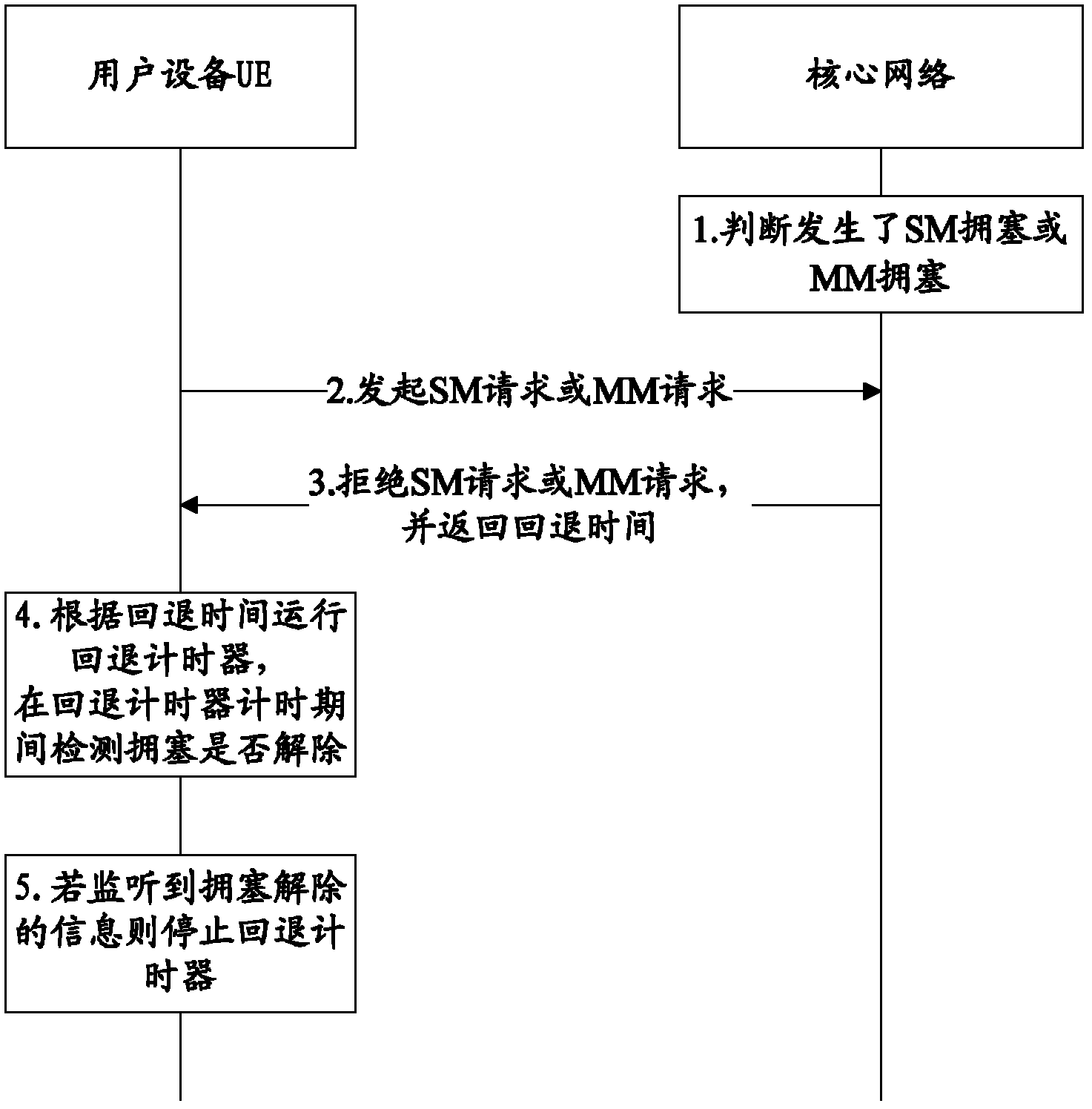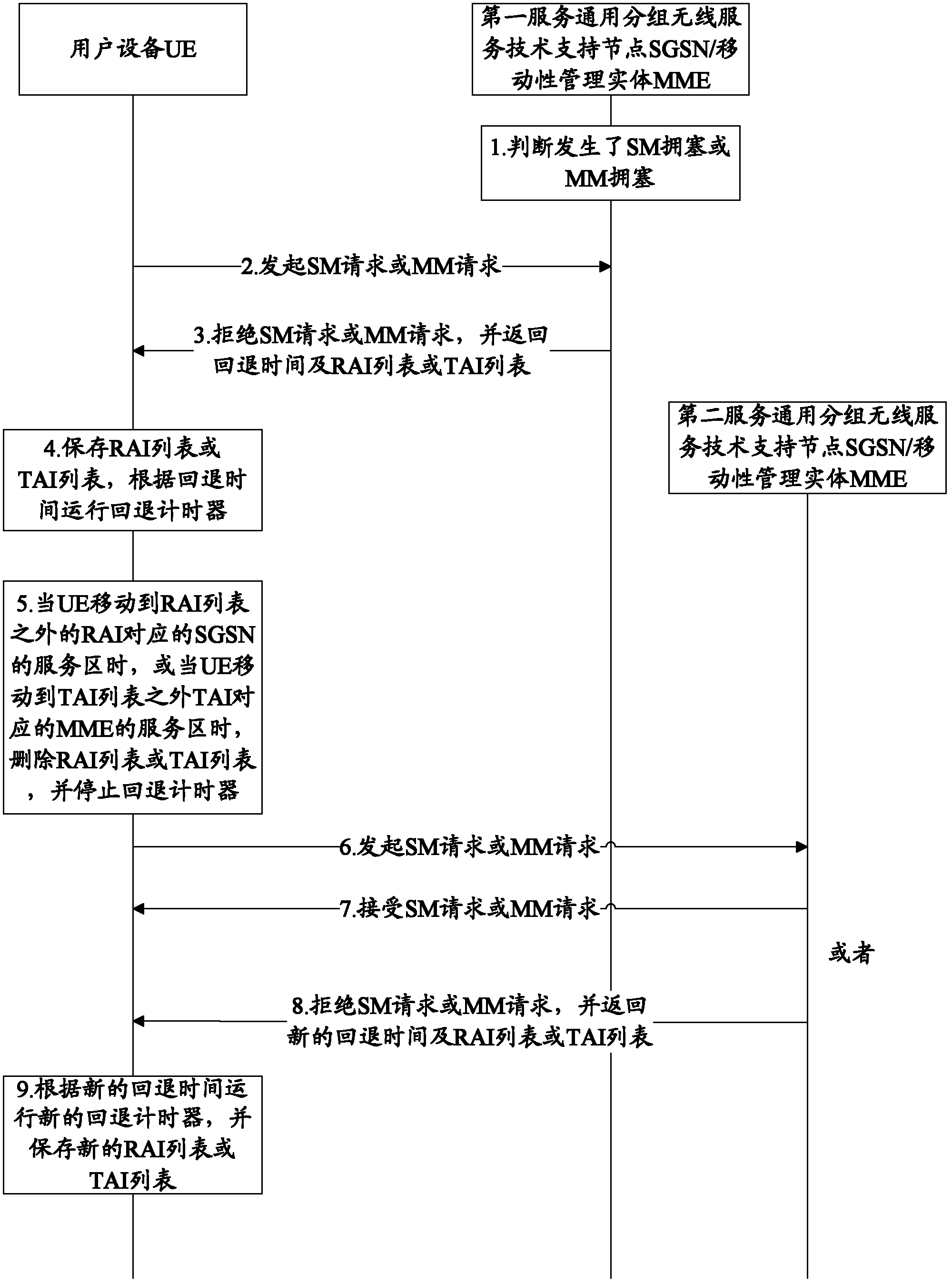Method and device for congestion control and user equipment
A user equipment, congestion control technology, applied in the field of communication, can solve the problem that UE cannot be informed in time
- Summary
- Abstract
- Description
- Claims
- Application Information
AI Technical Summary
Problems solved by technology
Method used
Image
Examples
Embodiment 1
[0082] Such as figure 1 What is shown is a flow chart of the congestion control method provided by the first embodiment of the present invention. For ease of description, only the parts related to the embodiment of the present invention are shown.
[0083] 1. The core network determines that SM congestion or MM congestion has occurred.
[0084] In this embodiment of the present invention, SM congestion or MM congestion includes, but is not limited to: APN-based SM congestion, or APN-based MM congestion, or general NAS-level MM congestion. The core network includes one or more serving general packet radio service technical support nodes (Servicing GPRS Support Node, SGSN) and / or mobility management entities (Mobility Management Entity, MME).
[0085] 2. The UE initiates an SM request or MM request to the core network.
[0086] 3. The core network rejects the SM request or MM request initiated by the UE, and returns the backoff time.
[0087] In the embodiment of the present ...
Embodiment 2
[0103] Such as figure 2 Shown is a flow chart of the congestion control method provided by the second embodiment of the present invention, and for ease of description, only the parts related to the embodiment of the present invention are shown.
[0104] 1. The core network determines that SM congestion or MM congestion has occurred.
[0105] 2. The UE initiates an SM request or MM request to the core network.
[0106] 3. The core network rejects the SM request or MM request initiated by the UE, and returns the backoff time.
[0107] 4. The UE runs the backoff timer according to the backoff time.
[0108] In the embodiment of the present invention, if the core network returns a message rejecting the MM request, the reject message will not allocate a RAI or a TAI list (multiple TAIs) to the UE, and the UE should save the current RAI or TAI by itself. When running the back-off timer, the UE prohibits the SM or MM procedure initiated by itself, but does not prohibit the SM or ...
Embodiment 3
[0118] Such as image 3 Shown is a flow chart of the congestion control method provided by the third embodiment of the present invention, and for ease of description, only the parts related to the embodiment of the present invention are shown.
[0119] In the embodiment of the present invention, the core network includes multiple SGSNs or MMEs. Here, the UE moves from the first SGSN / MME to the second SGSN / MME as an example for illustration.
[0120] 1. The first SGSN / MME determines that SM congestion or MM congestion has occurred.
[0121] 2. The UE initiates an SM request or an MM request to the first SGSN / MME.
[0122] 3. The first SGSN / MME rejects the SM request or MM request initiated by the UE, and returns the fallback time and the RAI list or TAI list.
[0123] In the embodiment of the present invention, the RAI list indicates a service area of an SGSN, and the TAI list indicates a service area of an MME.
[0124] 4. The UE saves the RAI list or the TAI list, and ...
PUM
 Login to View More
Login to View More Abstract
Description
Claims
Application Information
 Login to View More
Login to View More - R&D Engineer
- R&D Manager
- IP Professional
- Industry Leading Data Capabilities
- Powerful AI technology
- Patent DNA Extraction
Browse by: Latest US Patents, China's latest patents, Technical Efficacy Thesaurus, Application Domain, Technology Topic, Popular Technical Reports.
© 2024 PatSnap. All rights reserved.Legal|Privacy policy|Modern Slavery Act Transparency Statement|Sitemap|About US| Contact US: help@patsnap.com










